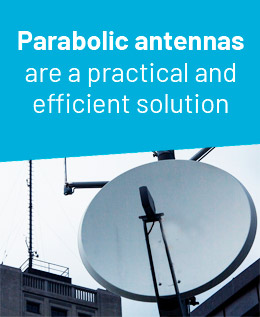Installing a satellite dish requires knowledge of the installation and mounting process. It is important to ensure that the location of the dish is appropriate and that it is properly mounted on a wall or other structure. In addition to the correct positioning of the dish, it is also necessary to ensure that all cables and connectors are connected correctly and that any additional components, such as an amplifier or antenna rotator, are installed correctly. The entire installation process should be supervised by a professional for safety reasons and to ensure that the satellite dish will perform optimally.

Contents
What is a satellite dish for?
Satellite dishes are important devices for receiving television and internet signals via satellite. They are a practical and effective solution for receiving these services in areas where terrestrial signal is limited or unavailable.
A satellite dish is a device used to receive television or internet signals via satellite. These antennas are designed to pick up signals from communications satellites and transmit them to a receiver that decodes the signal and converts it into television pictures or internet data.
Satellite dish orientation

Satellite dishes are commonly used in areas where terrestrial television or internet signal is limited or unavailable. For example, in rural areas where there is no infrastructure to carry the television or internet signal through cables, satellite dishes are a practical and effective solution to receive these services.
The orientation of the satellite dish is very important to get a good signal. When orienting the satellite dish a professional has to take into account several parameters in order to orientate a satellite dish effectively:
Location: A suitable location should be chosen for the satellite dish. It should be located in a place free of obstructions, such as trees or buildings, that may interfere with the signal to receive the desired signal.
Identify the correct direction: To find the correct direction of the antenna you can use an antenna orientation tool that can be found online. It is also advisable to consult the website of the company providing the TV or internet signal to find the right direction.
Adjusting the elevation: Once you have positioned the dish in the correct direction, you need to adjust the elevation of the dish. This can be done by using a signal meter or by adjusting the antenna manually until the best position is found.
Adjusting the direction: After adjusting the elevation, adjust the direction of the antenna by moving the antenna to the right or left until you find the position where the signal quality is optimal.
Satellite dish installation
If you need to install a satellite dish and prefer to rely on the expertise of a professional antenna installer, here are the steps the technician can follow to carry out an effective installation:
- Site assessment: The antenna installer will carry out an assessment of the site where the satellite dish will be installed to ensure that there are no obstructions that could affect the signal. The location of the TV or device that will receive the signal will also be assessed to determine the length and type of cable required.
- Choosing the right antenna: The antenna specialist will choose the right satellite dish for your needs. The choice will depend on factors such as how far away the desired signal is, the quality of the signal and the number of devices that will be connected to the dish.
- Antenna installation: Once the appropriate antenna has been chosen, the antenna installer will proceed with the installation of the antenna in the chosen location. The antenna will be placed on a sturdy mount and the elevation and direction will be adjusted as necessary.
- Cable connection: After installing the antenna, the antenna installer will connect the coaxial cable from the antenna to the TV or device that will receive the signal. Signal boosters will also be installed if needed to improve signal quality.
- Final adjustments: Once all connections have been made, the antenna specialist will make final adjustments to the antenna and equipment to ensure that the best possible signal quality is received.
- Testing and verification: Finally, to install a satellite dish, the antenna specialist will carry out tests to verify that the antenna is working properly. He or she will ensure that a good signal quality is being received on the TV or device and will resolve any problems that may arise.
Installing a satellite dish can be a daunting task for many, but it doesn’t have to be. Hiring a professional satellite dish installer is the best option for most. These antenna installers can connect the dish directly to your television and will also ensure that the dish is properly aligned to receive the best signal. Professional satellite dish installers are experienced in setting up the dish and will be able to get you up and running in no time.






